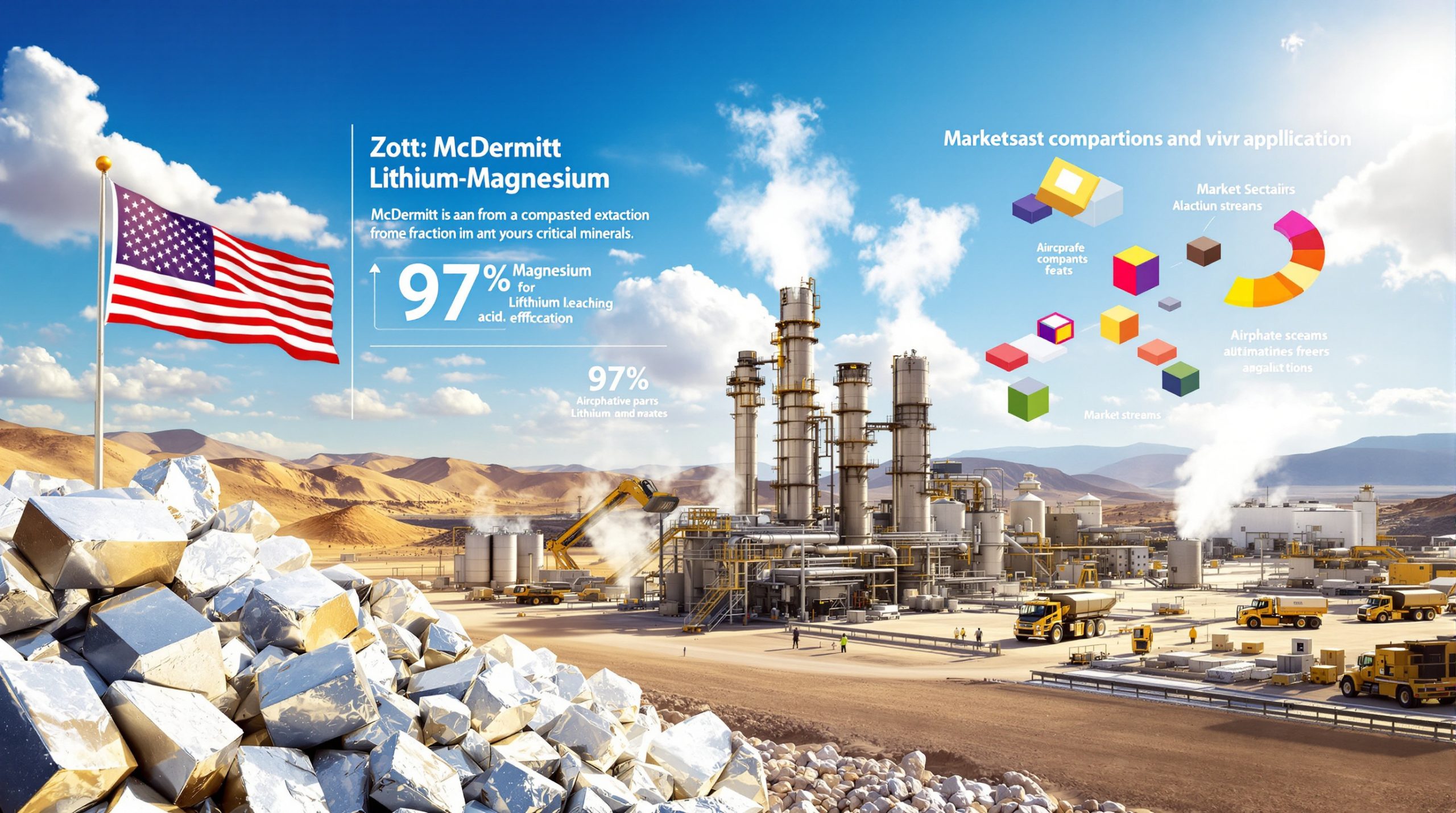What Makes the US-Australia Critical Minerals Partnership Strategically Essential?
The US-Australia critical minerals partnership represents a fundamental transformation in global resource diplomacy, targeting supply chain vulnerabilities that have exposed Western economies to unprecedented geopolitical risks. This comprehensive framework addresses critical dependencies across defense manufacturing, renewable energy infrastructure, and advanced technology sectors.
Furthermore, the partnership emerged from urgent recognition that China's overwhelming dominance in critical mineral processing creates systemic vulnerabilities for Western supply chains. Industry leaders emphasise that while many nations possess substantial mineral reserves, few have developed the sophisticated separation and refining capabilities necessary for finished products.
Core Strategic Objectives Driving the Alliance
The framework targets four primary strategic objectives that address the most pressing vulnerabilities in Western supply chains:
• Supply Chain Diversification: Moving away from single-source dependencies that create strategic vulnerabilities
• Processing Capability Development: Accelerating domestic refining and separation facilities in both nations
• Defense Industrial Resilience: Strengthening the defense manufacturing base through secure mineral supply chains
• Technology Manufacturing Pathways: Creating alternative routes for critical technology production outside Chinese influence
These objectives directly respond to China's integrated approach to critical mineral control. Moreover, this strategy extends from raw extraction through finished product manufacturing, highlighting the importance of energy transition minerals in modern supply chains.
Investment Framework and Implementation Timeline
The partnership establishes aggressive investment commitments designed to rapidly develop processing capabilities rather than focusing solely on raw extraction. This strategic approach targets the most vulnerable segments of the supply chain where bottlenecks traditionally occur and Chinese dominance is most pronounced.
Consequently, the framework prioritises immediate action over long-term planning, with industry experts noting that meaningful supply chain diversification typically requires 5-7 years for processing facilities and 3-5 years for expanded mining operations. The accelerated timeline reflects the urgent nature of addressing strategic vulnerabilities that have been exposed by recent geopolitical tensions.
Warren Pearce, CEO of Australia's Association of Mining and Exploration Companies, emphasised the critical importance of US commitment to project viability. He stated that the partnership enables Australian projects to move forward with confidence regarding market sustainability and long-term demand.
How Does China's Market Dominance Shape This Strategic Response?
Beijing maintains overwhelming control across the entire critical minerals value chain, with approximately 70% of global rare earth mining, 90% of separation processing, and 93% of permanent magnet manufacturing. This concentration creates systemic vulnerabilities for Western supply chains, particularly in defense and clean energy sectors where alternative sources remain limited.
| Supply Chain Stage | China's Market Share | Strategic Vulnerability Level |
|---|---|---|
| Raw Material Mining | 70% | Moderate – alternatives exist |
| Separation & Processing | 90% | High – limited global capacity |
| Magnet Manufacturing | 93% | Critical – few viable alternatives |
Understanding China's Integrated Supply Chain Control
China's competitive advantage extends far beyond natural resource endowments. Professor John Mavrogenes from the Australian National University highlighted China's comprehensive approach, noting that China not only extracts significant rare earth quantities but processes them through separation, metallisation, and final product manufacturing, including the most strategically important permanent magnets.
This vertical integration creates multiple layers of dependency for Western manufacturers. Even nations with substantial domestic rare earth production, such as the United States and Australia, often rely on Chinese processing facilities to convert raw materials into usable industrial inputs.
In addition, the integration advantage is further reinforced by China's technological dominance in separation processes. Industry experts note that China has been particularly effective in developing proprietary intellectual property and advanced processing technology while limiting technology transfer to potential competitors.
Recent Export Control Escalations
China's evolving export control mechanisms represent a significant escalation in resource diplomacy tactics. Recent requirements for government approval on magnet exports containing even trace amounts of Chinese-origin materials demonstrate Beijing's expanding definition of strategic control.
This policy framework extends Chinese influence beyond direct exports to encompass global manufacturing networks that utilise Chinese-origin technology, materials, or processing techniques. The implications affect manufacturers worldwide who incorporate Chinese rare earth elements into their supply chains, regardless of final product destination.
The export control evolution follows a pattern of gradually expanding restrictions that target increasingly downstream applications. It moves from raw materials to intermediate products and now finished goods containing Chinese content, affecting critical minerals for semiconductors production globally.
Which Critical Minerals Drive Modern Technology Dependencies?
The US-Australia critical minerals partnership encompasses 31 minerals classified as critical by Australia, including rare earth elements that form the technological backbone of contemporary infrastructure. These materials enable everything from renewable energy systems to advanced defense applications.
Rare earth elements comprise approximately 17 elements on the periodic table. Each has unique magnetic characteristics that have become integral to everyday technologies and emerging green energy applications.
Rare Earth Elements and Their Critical Applications
Permanent Magnet Technologies:
• Neodymium and Dysprosium: Essential for wind turbine generators, enabling efficient electrical energy conversion
• Samarium and Terbium Compounds: Critical for electric vehicle motors requiring high-temperature performance
• Praseodymium-Based Components: Utilised in defense systems requiring precise magnetic field control
• Gadolinium and Europium: Enable advanced consumer electronics with specialised magnetic properties
Professor John Mavrogenes emphasised the ubiquitous nature of these applications. He noted that permanent rare earth magnets power everything from wind turbines and electric vehicles to escalators, elevators, refrigerators, and even small motors in consumer products like electric razors.
The magnetic properties of rare earth elements represent their unique value proposition in modern technology applications. These characteristics cannot be easily replicated by alternative materials, creating structural dependencies that extend across multiple industrial sectors.
Beyond Rare Earths: Additional Critical Mineral Categories
Strategic Mineral Applications:
• Lithium: Battery technology and energy storage systems enabling renewable energy integration
• Gallium: Semiconductor manufacturing and defense electronics requiring specialised compound semiconductors
• Magnesium: Lightweight alloys for aerospace applications demanding optimal strength-to-weight ratios
• Zirconium: Nuclear industry applications and specialised ceramics requiring extreme temperature resistance
These minerals complement rare earth elements in creating comprehensive technological ecosystems that span civilian and military applications. The interdependencies between different critical minerals create complex supply chain vulnerabilities that require coordinated strategic responses. Furthermore, Australia's strategic mineral reserves play a crucial role in supporting these technology sectors.
What Are the Key Projects Receiving Priority Investment?
The framework identifies specific initiatives receiving accelerated funding and regulatory support. It focuses strategically on processing capabilities rather than raw extraction. This approach directly addresses the supply chain segments where Chinese dominance creates the most significant vulnerabilities.
Alcoa-Sojitz Gallium Recovery Initiative
Located in Wagerup, Western Australia, this facility represents an innovative approach to critical mineral supply chain development. The project targets approximately 10% of global gallium demand through recovery processes integrated with existing bauxite processing operations.
Gallium's critical importance in semiconductor manufacturing and defense electronics applications makes this project strategically significant for both nations' technology sectors. The recovery approach demonstrates how existing industrial infrastructure can be leveraged to develop critical mineral capabilities without requiring entirely new mining operations.
The facility's integration with established bauxite processing creates operational synergies. These improve project economics while reducing environmental footprints compared to dedicated mining operations.
Arafura Nolans Rare Earth Development
The Northern Territory project targets 5% of global rare earth production with processing capabilities designed specifically to reduce dependence on Chinese separation facilities. This vertical integration approach addresses the most vulnerable segment of the rare earth supply chain.
The project's significance extends beyond production volumes to encompass processing technology development and knowledge transfer between Australian and American companies. This technological collaboration aspect represents a crucial component of long-term supply chain resilience.
Unlike traditional Australian mining operations that export raw or partially processed materials, the Nolans project incorporates sophisticated separation capabilities. These mirror Chinese processing facilities, creating genuine supply chain alternatives and supporting mineral beneficiation opportunities globally.
How Do Global Reserve Distributions Compare to Production Realities?
Understanding the disconnect between mineral reserves and actual production capabilities reveals why processing infrastructure matters more than raw material abundance. This determines strategic advantage and market power in critical mineral supply chains.
Global Rare Earth Reserve Rankings
| Country | Estimated Reserves (Million Tonnes) | 2024 Production (Thousand Tonnes) | Production Efficiency |
|---|---|---|---|
| China | 44.0 | 270 | 6.1 tonnes per million reserves |
| Brazil | 21.0 | ~1 | 0.05 tonnes per million reserves |
| India | 6.9 | ~3 | 0.4 tonnes per million reserves |
| Australia | 5.7 | 13 | 2.3 tonnes per million reserves |
| United States | 1.9 | 45 | 23.7 tonnes per million reserves |
The data reveals striking disparities between reserve holdings and production capabilities. Brazil possesses nearly half of China's reserves but produces minimal quantities, while the United States extracts proportionally far more from smaller reserve bases.
The Processing Gap Challenge
Professor John Mavrogenes provided crucial context regarding reserve assessments. He emphasised that large reserve figures require significant asterisks until comprehensive feasibility studies demonstrate profitable extraction, processing capability, and market access.
Countries with significant reserves often lack the complex processing infrastructure required to convert raw materials into usable industrial inputs. Australia's Mount Weld operation exemplifies this challenge perfectly, extracting substantial ore quantities that must be shipped to Malaysia for separation into individual rare earth elements.
The processing gap creates strategic vulnerabilities even for nations with substantial domestic mining capabilities. Raw material control provides limited strategic advantage without corresponding processing and manufacturing capacity to create finished products.
Technical complexity represents a fundamental barrier to processing capability development. Rare earth elements typically occur together in mixed deposits, requiring sophisticated chemical separation techniques. These rank among the most complex metallurgical processes in modern industrial operations.
What Environmental and Technical Hurdles Must Be Overcome?
Critical mineral processing involves substantial environmental considerations and technical challenges that significantly influence project viability. These factors affect development timelines and operational sustainability, often determining whether substantial reserve holdings translate into actual production capability.
Environmental Impact Management
Resource Intensity Challenges:
• Water Consumption: Processing operations require substantial water resources for separation and refining processes
• Radioactive Components: Some rare earth ore deposits contain thorium and uranium, creating specialised handling requirements
• Waste Management: Separation processes generate significant tailings requiring long-term environmental management
• Energy Intensity: Refining operations demand substantial power inputs, affecting project economics and carbon footprints
Professor John Mavrogenes noted that environmental factors represent significant considerations for countries evaluating rare earth development projects. He questioned whether nations are willing to accept environmental sacrifices associated with large-scale processing operations.
Even countries with strong environmental management records must develop innovative approaches to meet water requirements and waste management needs for rare earth processing facilities. These technical challenges often prove more constraining than raw material availability.
Technical Processing Complexities
Rare earth separation represents one of the most technically sophisticated processes in modern extractive industries. The elements typically occur together in mixed deposits, requiring advanced chemical techniques to isolate individual elements needed for specific industrial applications.
The separation chemistry involves complex multi-stage processes that require specialised equipment, technical expertise, and substantial capital investment. These technical barriers partially explain why so few nations have developed competitive processing capabilities despite widespread rare earth deposits.
China's dominance in processing stems partly from decades of investment in developing and refining these sophisticated separation technologies. This creates intellectual property advantages that extend beyond natural resource endowments, particularly relevant given Trump's critical minerals order emphasising domestic capabilities.
How Will This Partnership Reshape Global Supply Chain Dynamics?
The bilateral framework signals a fundamental shift toward regionalised supply chains, potentially fragmenting the global critical minerals market along geopolitical alliance lines. This transformation carries significant implications for pricing structures, technology transfer patterns, and strategic stockpiling approaches.
Anticipated Market Structure Changes
Emerging Supply System Characteristics:
• Dual Network Development: Separate Western and Chinese-aligned supply systems operating with limited integration
• Premium Pricing Structures: Alternative suppliers commanding higher prices compared to Chinese sources, reflecting strategic value
• Accelerated Technology Transfer: Non-Chinese processing methods receiving increased development investment and knowledge sharing
• Strategic Reserve Expansion: Government stockpiling programmes designed to buffer supply disruptions during transition periods
The market fragmentation reflects broader geopolitical tensions that prioritise supply security over economic efficiency. Strategic considerations increasingly outweigh cost factors in critical mineral procurement decisions across Western economies.
Timeline for Supply Chain Transformation
Industry analysis suggests meaningful supply chain diversification requires 5-7 years for processing facilities and 3-5 years for expanded mining operations. The partnership's aggressive timeline reflects urgency in addressing strategic vulnerabilities that recent geopolitical events have highlighted.
Warren Pearce emphasised that Australia had been developing critical mineral capabilities ahead of other countries but remained far behind China's integrated approach. The US partnership commitment provides market confidence necessary for accelerated project development and investment commitment, according to official government frameworks.
The transformation timeline assumes sustained political support across multiple election cycles in both nations. This represents a significant implementation risk for long-term project viability and strategic effectiveness.
What Investment Opportunities Emerge from This Strategic Shift?
The framework creates substantial opportunities across the critical minerals value chain, from mining operations through advanced manufacturing. However, these opportunities come with considerable technical, regulatory, and market risks that require careful evaluation.
Priority Investment Sectors
High-Priority Development Areas:
• Processing Facility Development: Separation and refining capabilities representing the highest strategic value
• Manufacturing Equipment: Magnet production and specialised alloy manufacturing technologies
• Research and Development: Alternative processing technologies reducing Chinese technology dependencies
• Infrastructure Development: Transportation and storage facilities supporting integrated supply chains
The investment focus on processing capabilities rather than raw extraction reflects strategic analysis identifying separation technology as the primary competitive bottleneck in global supply chains. This approach aligns with broader critical minerals analysis from strategic research institutions.
Risk Considerations for Investors
Critical Risk Factors:
• Regulatory Uncertainty: Evolving trade policies and export controls affecting market access and profitability
• Technical Challenges: Unproven processing technologies requiring demonstration at commercial scale
• Market Competition: Chinese price competition and potential capacity expansion responses
• Environmental Compliance: Stringent permitting requirements and operational environmental management costs
Professor John Mavrogenes highlighted the complexity of determining project viability. He noted that even projects with favourable reserve characteristics require comprehensive analysis of extraction feasibility, processing capability, and market access before investment commitment.
The technical difficulty of rare earth processing creates barriers to entry that protect successful operations. However, it also increases development risks for new projects attempting to replicate Chinese processing capabilities.
Frequently Asked Questions About the US-Australia Critical Minerals Partnership
Why Focus on Processing Rather Than Mining?
Processing represents the primary bottleneck in critical mineral supply chains where Chinese dominance creates the most significant strategic vulnerabilities. While many countries possess substantial raw material deposits, few have developed the complex separation and refining capabilities necessary for finished product manufacturing.
The processing focus addresses supply chain segments where alternatives to Chinese facilities are most limited. Furthermore, technical barriers create the highest competitive advantages for successful operations.
How Long Will Supply Chain Diversification Take?
Meaningful diversification requires 5-10 years for full implementation across integrated supply chains. Processing facilities typically need 3-5 years for construction and commissioning, while mining operations require 5-7 years from development through commercial production.
The timeline assumes sustained political commitment, adequate financing, successful technology transfer, and favourable regulatory environments in both nations throughout the development period.
What Role Do Strategic Stockpiles Play?
Both nations maintain strategic reserves designed to buffer supply disruptions during the transition period while alternative supply chains develop operational capacity. These stockpiles provide security against short-term supply interruptions but cannot address long-term strategic dependencies.
Strategic reserves complement supply chain development rather than replacing the need for processing capability development and market diversification initiatives.
How Will This Affect Global Pricing?
Alternative supply chains typically command premium pricing compared to Chinese sources due to higher processing costs and smaller economies of scale. However, strategic considerations increasingly outweigh cost factors in critical mineral procurement decisions across defense and renewable energy sectors.
Premium pricing reflects the strategic value of supply security and reduced geopolitical risk rather than simply higher production costs. This creates sustainable pricing advantages for alternative suppliers.
Transforming Strategic Vulnerabilities into Competitive Advantages
The US-Australia critical minerals partnership represents more than bilateral cooperation, signalling a fundamental restructuring of global resource networks around strategic alliance systems. Success depends on execution speed, technological innovation, and sustained political commitment across multiple election cycles in both nations.
The framework's emphasis on processing capabilities directly addresses the most critical vulnerabilities in Western supply chains. Meanwhile, aggressive investment timelines reflect urgent recognition of strategic dependencies that recent geopolitical events have exposed. For investors and industry participants, this partnership creates significant opportunities alongside considerable implementation challenges.
The transformation from strategic vulnerability to competitive advantage requires coordinated action across government policy, private investment, and technology development. The partnership's success will largely determine whether Western nations can develop genuine alternatives to Chinese critical mineral dominance or remain dependent on existing supply chains despite significant investment in alternative capabilities.
Disclaimer: This analysis is based on publicly available information and industry expert opinions. Investment decisions should be made in consultation with qualified financial advisors and after thorough due diligence. Market conditions, regulatory environments, and geopolitical factors may change significantly, affecting project viability and investment outcomes.
Ready to Capitalise on Critical Minerals Opportunities?
The US-Australia critical minerals partnership is creating unprecedented opportunities across the resource value chain, from processing facilities to advanced manufacturing technologies. Discovery Alert's proprietary Discovery IQ model delivers real-time alerts on significant ASX mineral discoveries, instantly empowering subscribers to identify actionable opportunities in this rapidly evolving strategic sector ahead of the broader market. Begin your 30-day free trial today and secure your market-leading advantage in critical minerals investing.




